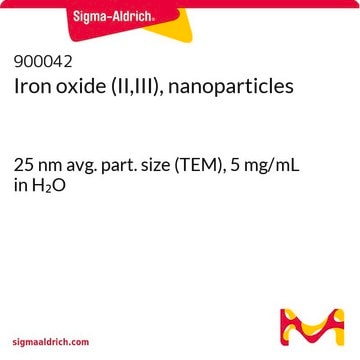720704
Iron(III) oxide, dispersion
nanoparticles, ≤110 nm particle size, 20 wt. % in H2O
Sinonimo/i:
Iron oxide in water
Autenticatiper visualizzare i prezzi riservati alla tua organizzazione & contrattuali
About This Item
Formula empirica (notazione di Hill):
Fe2O3
Numero CAS:
Peso molecolare:
159.69
Numero MDL:
Codice UNSPSC:
12352300
ID PubChem:
NACRES:
NA.23
Prodotti consigliati
Stato
nanoparticles
Livello qualitativo
Concentrazione
20 wt. % in H2O
Dimensione particelle
≤110 nm
pH
6-8
Densità
1.17 g/mL±0.1 g/mL at 25 °C
Stringa SMILE
O=[Fe]O[Fe]=O
InChI
1S/2Fe.3O
JEIPFZHSYJVQDO-UHFFFAOYSA-N
Cerchi prodotti simili? Visita Guida al confronto tra prodotti
Codice della classe di stoccaggio
10 - Combustible liquids
Classe di pericolosità dell'acqua (WGK)
nwg
Punto d’infiammabilità (°F)
Not applicable
Punto d’infiammabilità (°C)
Not applicable
Scegli una delle versioni più recenti:
Possiedi già questo prodotto?
I documenti relativi ai prodotti acquistati recentemente sono disponibili nell’Archivio dei documenti.
I clienti hanno visto anche
Magnetic iron oxide nanoparticles: synthesis, stabilization, vectorization, physicochemical characterizations, and biological applications
Laurent S, et al.
Chemical Reviews, 108(6), 2064-2110 (2008)
Brian T Farrell et al.
Neurology, 81(3), 256-263 (2013-06-19)
The study goal was to assess the benefits and potential limitations in the use of ultrasmall superparamagnetic iron oxide (USPIO) nanoparticles in the MRI diagnosis of CNS inflammatory diseases and primary CNS lymphoma. Twenty patients with presumptive or known CNS
J Sangeetha et al.
Journal of biomedical nanotechnology, 9(5), 751-764 (2013-06-28)
We present methodologies to functionalize iron oxide (Fe3O4) nanoparticles with biosurfactants and biocompatibility results. Positively charged Fe3O4 nanoparticles of average hydrodynamic size -26 nm is functionalized with four different molecules of interest, viz., surfactin, rhamnolipid, polyethylene glycol (PEG) and dextran.
Alice Panariti et al.
Journal of biomedical nanotechnology, 9(9), 1556-1569 (2013-08-29)
Magnetic nanoparticles have emerged as important players in current research in modern medicine since they can be used in medicine for diagnosis and/or therapeutic treatment of diseases. Among many therapeutic applications of iron-based nanoparticles, drug delivery and photothermal therapy are
Rajenahally V Jagadeesh et al.
Science (New York, N.Y.), 342(6162), 1073-1076 (2013-11-30)
Production of anilines--key intermediates for the fine chemical, agrochemical, and pharmaceutical industries--relies on precious metal catalysts that selectively hydrogenate aryl nitro groups in the presence of other easily reducible functionalities. Herein, we report convenient and stable iron oxide (Fe2O3)-based catalysts
Il team dei nostri ricercatori vanta grande esperienza in tutte le aree della ricerca quali Life Science, scienza dei materiali, sintesi chimica, cromatografia, discipline analitiche, ecc..
Contatta l'Assistenza Tecnica.



